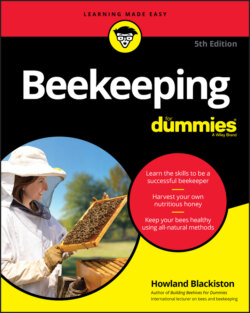Читать книгу Beekeeping For Dummies - Howland Blackiston - Страница 66
Egg
ОглавлениеThe metamorphosis begins when the queen lays an egg. You should learn how to spot eggs because that is one of the most basic and important skills you need to develop as a beekeeper. It isn’t an easy task because the eggs are mighty tiny (only about 1.7 millimeters long). But finding eggs is one of the surest ways to confirm that your queen is alive and well. It’s a skill you’ll use just about every time you visit your hive.
The queen lays a single egg in each cell that has been cleaned and prepared by the workers to raise new brood (see Figure 2-9). The cell must be spotless, or she moves on to another one.
If she chooses a standard worker-size cell, she releases a fertilized egg into the cell. That egg develops into a worker bee (female). But if she chooses a wider, drone-size cell, the queen releases her egg but not sperm; for example, a nonfertilized egg. That egg develops into a drone bee (male). The workers that build the cells regulate the ratio of female worker bees to male drone bees. They do this by building smaller cells for female worker bees and larger cells for male drone bees.
Having said all that, not all fertilized eggs develop into worker bees. Some can develop into a regal queen bee. But more on that in Chapter 14.
The queen positions the egg in an upright position (standing on end) at the bottom of a cell. That’s why they’re so hard to see. When you look straight down into the cell, you’re looking at the minuscule diameter of the egg, which is only 0.4 millimeter wide. Figure 2-10 shows a microscopic close-up of a single egg.
Courtesy of Howland Blackiston
FIGURE 2-9: Note the rice-like shape of the eggs and how the queen has positioned them standing up in the cells.
Courtesy of Alexander Wild, www.alexanderwild.com
FIGURE 2-10: A single egg.
Eggs are much easier to spot on a bright, sunny day. Hold the comb at a slight angle, with the sun behind you and shining over your shoulder, illuminating the deep recesses of the cell. The eggs are translucent white and resemble a miniature grain of rice. I recommend that you invest in an inexpensive pair of reading glasses. Better yet, get yourself a pair of magnifying goggles such as those used by watchmakers and model makers (see Figure 2-11).The magnification can really help you spot the eggs (even if you don’t normally need reading glasses). After you discover your first egg, it’ll be far easier to know what you’re looking for during future inspections.
Courtesy of Howland Blackiston
FIGURE 2-11: These magnifying goggles (used by watchmakers and model makers) are a great beekeeping tool for finding those itty-bitty eggs.
